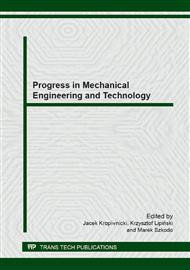[1]
Y. Bai, B. Mao, F. Zhou, Y. Ding, Ch. Dong, Energy-Efficient Driving Strategy for Freight Trains Based on Power Consumption Analysis. J Transpn Sys Eng & IT, 2009, 9(3), 43-50.
DOI: 10.1016/s1570-6672(08)60062-8
Google Scholar
[2]
A. Balcerski, Z. Kneba, J. Kropiwnicki, S. Makowski, The conception of exploitation efficiency of autonomic energy systems of land vehicles and ships. Combustion Engines R. 48, nr SC2, Mixture Formation, Ignition and Combustion, 2009, s. 70-76.
Google Scholar
[3]
A. Balcerski, Modele probalistyczne w teorii projektowania i eksploatacji spalinowych siłowni okrętowych. Fundacja Promocji Przemysłu Okrętowego i Gospodarki Morskiej, Gdańsk (2007).
Google Scholar
[4]
P. Boguś, R. Grzeszczyk, Wykrywanie i detekcja stanu pojazdu szynowego z użyciem GPS oraz innych pokładowych urządzeń rejestrujących. Pojazdy Szynowe nr 2/2010, s. 13-23.
DOI: 10.53502/rail-139716
Google Scholar
[5]
Y. Ding, F. Zhou, Y. Bai, R. Li, B. Mao, Train Grade Resistance Calculation Modification Model Based on Measured Data. J Transpn Sys Eng & IT, 2010, 10(6), 82−88.
DOI: 10.1016/s1570-6672(09)60075-1
Google Scholar
[6]
E. Domański, Z. Ożóg, Lokomotywy spalinowe serii ST44. Wydawnictwa Komunikacji i Łączności, Warszawa (1984).
Google Scholar
[7]
ENTE Sp. z o. o. METRONIX, System monitorowania zużycia paliwa i wspierania procesów logistycznych przewoźnika kolejowego. Konferencja nowoczesne rozwiązania dla taboru szynowego. Radiokomunikacja kolejowa. Gdańsk 19–20 lutego 2008 r.
Google Scholar
[8]
J. Gronowicz, Energochłonność transport kolejowego. Trakcja spalinowa. Wydawnictwo Komunikacji i Łączności, Warszawa (1990).
Google Scholar
[9]
J. Gronowicz, Studium nad estymatami energetycznymi lokomotywy spalinowej z przekładnią elektryczną. WPP Rozprawy, nr 140, (1982).
Google Scholar
[10]
J. Gronowicz, B. Kasprzak: Lokomotywy spalinowe. Wydawnictwa Komunikacji i Łączności, Warszawa (1984).
Google Scholar
[11]
M. Janiak, G. Krzyżaniak, Urządzenia Mechaniczne w inżynierii środowiska, Część II. Wydawnictwo Politechniki Poznańskiej, Poznań (1999).
Google Scholar
[12]
R.R. Liu, I.M. Golovitcher, Energy-efficient operation of rail vehicles. Transportation Research Part A 37 (2003) 917-932.
DOI: 10.1016/j.tra.2003.07.001
Google Scholar
[13]
D. Park, Y. Yoon, S-B. Kwon, W. Jeong, Y. Cho, K. Lee: The effects of operating conditions on particulate matter exhaust from diesel locomotive engines. Science of the Total Environment 419 (2012), 76–80.
DOI: 10.1016/j.scitotenv.2012.01.002
Google Scholar
[14]
D.C. Petrilean: Method of calculus for power input of the helical screw compressor. U.P.B. Sci. Bull. Series D, Vol. 71, Iss. 4, (2009).
Google Scholar
[15]
Pojazdy Szynowe PESA Bydgoszcz S.A.: Dokumentacja techniczno-ruchowa modernizacji lokomotywy typu M-62. Bydgoszcz, (2011).
Google Scholar
[16]
Ch. Tang, Y. Mo, W. Zhou: Application of fuzzy and binary algorithm to regulation of load in locomotive load test, Second International Conference on Mechanic Automation and Control Engineering, (2011), 96-99.
DOI: 10.1109/mace.2011.5986866
Google Scholar
[17]
ZEPWN Jerzy Czerwiński i wspólnicy – Spółka Jawna: System CL400 do kontroli zużycia paliwa w lokomotywach spalinowych z przekładnią elektryczną. Ulotka informacyjna. http: /zepwn. com. pl.
Google Scholar


